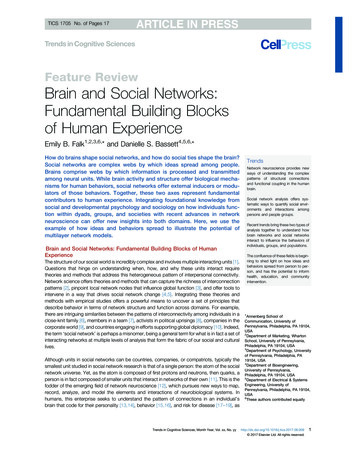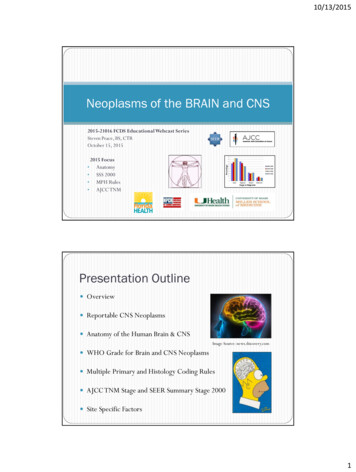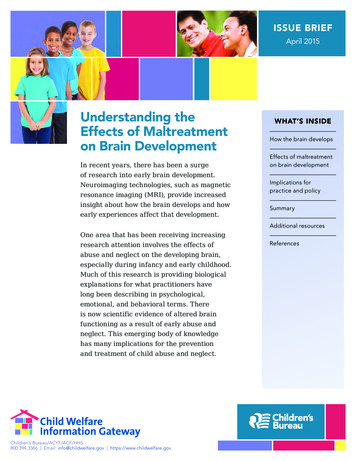
Transcription
TICS 1705 No. of Pages 17Feature ReviewBrain and Social Networks:Fundamental [371 TD IF]Building Blocksof Human ExperienceEmily B. Falk1,2,3,6,* and Danielle S. Bassett4,5,6,*How do brains shape social networks, and how do social ties shape the brain?Social networks are complex webs by which ideas spread among people.Brains comprise webs by which information is processed and transmittedamong neural units. While brain activity and structure offer biological mechanisms for human behaviors, social networks offer external inducers or modulators of those behaviors. Together, these two axes represent fundamentalcontributors to human experience. Integrating foundational knowledge fromsocial and developmental psychology and sociology on how individuals function within dyads, groups, and societies with recent advances in networkneuroscience can offer new insights into both domains. Here, we use theexample of how ideas and behaviors spread to illustrate the potential ofmultilayer network models.TrendsNetwork neuroscience provides newways of understanding the complexpatterns of structural connectionsand functional coupling in the humanbrain.Social network analysis offers systematic ways to quantify social environments and interactions amongpersons and people groups.Recent trends bring these two types ofanalysis together to understand howbrain networks and social networksinteract to influence the behaviors ofindividuals, groups, and populations.[375 TD IF] Brain and Social Networks: Fundamental Building Blocks of HumanExperienceThe structure of our social world is incredibly complex and involves multiple interacting units [1].Questions that hinge on understanding when, how, and why these units interact requiretheories and methods that address this heterogeneous pattern of interpersonal connectivity.Network science offers theories and methods that can capture the richness of interconnectionpatterns [2], pinpoint local network nodes that influence global function [3], and offer tools tointervene in a way that drives social network change [4,5]. Integrating these theories andmethods with empirical studies offers a powerful means to uncover a set of principles thatdescribe behavior in terms of network structure and function across domains. For example,there are intriguing similarities between the patterns of interconnectivity among individuals in aclose-knit family [6], members in a team [7], activists in political uprisings [8], companies in thecorporate world [9], and countries engaging in efforts supporting global diplomacy [10]. Indeed,the term ‘social network’ is perhaps a misnomer, being a general term for what is in fact a set ofinteracting networks at multiple levels of analysis that form the fabric of our social and culturallives.Although units in social networks can be countries, companies, or compatriots, typically thesmallest unit studied in social network research is that of a single person: the atom of the socialnetwork universe. Yet, [376 TD IF]as the atom is composed of first protons and neutrons, then quarks, aperson is in fact composed of smaller units that interact in networks of their own [11]. This is thefodder of the emerging field of network neuroscience [12], which pursues new ways to map,record, analyze, and model the elements and interactions of neurobiological systems. Inhumans, this enterprise seeks to understand the pattern of connections in an individual’sbrain that code for their personality [13,14], behavior [15,16], and risk for disease [17–19], asTrends in Cognitive Sciences, Month Year, Vol. xx, No. yyThe confluence of these fields is beginning to shed light on how ideas andbehaviors spread from person to person, and has the potential to informhealth, education, and communityintervention.1Annenberg School ofCommunication, University ofPennsylvania, Philadelphia, PA 19104,USA2Department of Marketing, WhartonSchool, University of Pennsylvania,Philadelphia, PA 19104, USA3Department of Psychology, Universityof Pennsylvania, Philadelphia, PA19104, USA4Department of Bioengineering,University of Pennsylvania,Philadelphia, PA 19104, USA5Department of Electrical & SystemsEngineering, University ofPennsylvania, Philadelphia, PA 19104,USA[37 TD IF]6These authors contributed 9 2017 Elsevier Ltd. All rights reserved.1
TICS 1705 No. of Pages 17well as [37 TD IF]for their potential to adapt to their surroundings [20], engage in meaningful relationshipswith others [21], and participate in a larger team [22]. Such predictive patterns of connectionsexist across diverse spatiotemporal scales [23] and can be argued to form a separate intrahuman layer in the multiscale social network hierarchy. These recent advances in networkneuroscience complement substantial advances in social and cognitive neuroscience that havemapped patterns of activity and the structure of the human brain within and across brainregions.Here, we review recent studies that have brought together questions of brain structure andfunction with insights from social network analysis. It is beyond the scope of this article toprovide a substantial review of the foundational literatures in social and developmental psychology and sociology [378 TD IF]on how individuals function within dyads, groups, and societies, and [379 TD IF]inneuroscience on how brain structure and function relate to the psychology of the individual.Instead, we argue that understanding brains and social networks in the context of one anotheris not only important, but also critically necessary, because the two are interacting systems:brain dynamics shape learning and behavior [24], including social interaction [25]; likewise,social contexts alter brain structure and function [26,27]. Integration of theories and methodslinking brain activity and structure to activity and structure within social networks holds greatpromise to improve our knowledge of the single human by improving our ability to predictbehavior, derive core psychological and neurocognitive principles, and distinguish brain healthand disease [28]. In addition, integration of social network and brain dynamics holds greatpromise to improve our knowledge of the collective by improving our ability to predict groupbehavior [29,30], gain deeper insight into underlying mechanisms, and potentially intervenemore efficiently. For example, questions of communication between individuals and acrossgroups, as well as broader classes of learning and decision making, can be conceptualizedboth in terms of the neural and psychological mechanisms supporting the decisions andbehaviors of each actor (e.g., a decision to share a piece of information or an unconscious facialresponse to learning a piece of information), as well as how individuals mutually influence oneanother. In these ways, linking brain and social networks opens new avenues for discoveringprinciples that fundamentally underlie individual decision making, person-to-person interactions, and the broader organization of society (Figure 1).Although several pieces of this puzzle remain to be discovered, we focus on one example, theneurobiology of how ideas and behaviors spread within social networks, to illustrate ways inwhich brain network dynamics and social network dynamics might be studied in parallel.Specifically, ideas and behaviors are transmitted and adopted over a period of time, eitherthrough verbal or nonverbal communication. This process involves biological coupling (e.g., oflanguage patterns [31–33] or nonverbal signals [34–36], and brain activity between communicators and receivers [37–39]). Given that the behavioral and cognitive processes supportingidea and behavior spread can change over time, tools to reveal their neurophysiologicalunderpinnings must be tuned to characterize and quantify temporally expansive phenomena.Complementing time-varying univariate approaches, including parametric modulation analysis[40], here we focus on dynamic network approaches as a natural set of tools that meet theserequirements, and that can specifically be used to understand interactions between brainsystems implicated in idea and behavior spread, including the value system and the defaultmode network[380 TD IF][41]. By characterizing patterns of functional connectivity and their changes overfine-scale temporal windows, these approaches can be used to map communication patternsbetween functionally specialized brain areas that either directly relate to interpersonal communication patterns occurring during the experiment, or that predict features of interpersonalcommunication occurring outside of the experiment over longer time windows. More generally,markers of brain connectivity (short timescale) can be linked in a correlative or causative manner2Trends in Cognitive Sciences, Month Year, Vol. xx, No. yy[374 TD IF]*Correspondence:falk@asc.upenn.edu (E.B. Falk) anddsb@seas.upenn.edu (D.S. Bassett).
TICS 1705 No. of Pages 17Figure 1. Building Hypotheses Bridging Brain Networks and Social Networks. How can we move from typicaldata collected in a neuroimaging experiment to a multiscale network? Neuralregions of interest [e.g., blue and greendots in (A)] can be treated as nodes in anetwork, connected to one another byestimates of white matter structure orby estimates of functional connectivity,such as a Pearson correlation betweenpairs of regional mean BOLD time series[e.g., in (A) the blue and green lines represent the time series from each region ofinterest over the course of a task in anMRI scanner; see also Box 1 in the maintext]. By encoding these relationships in aconnectivity matrix [depicted in shades ofred in (A)], one can first determine thestrength of connectivity between brainregions in a single individual during different task conditions [in (A), the weight ofthe edges connecting the regions of interest in the right-most brain image represents the strength of the correlationbetween the time series of those nodes].[327 TD IF]Such a matrix can be used to addresshypotheses about not only individualsacting in isolation, but also the interplaybetween brain networks supportingmutual influence between individuals insocial networks (e.g., processes facilitating the spread of ideas or behaviors), asdepicted by lines connecting brainregions across different people’s brainsin (B). In addition, it is possible to modelhow an individual’s social networkresources or placement within their socialnetwork relate to their brain or behavior,as depicted in (C). Adapted from [25].to communication patterns between people in social networks (longer timescale), therebyoffering an explicit mathematical framework for integration across this multiscale network.To unpack how [381 TD IF]a multiscale network perspective [382 TD IF]can inform both neural and social scientificquestions related to the spread of ideas and behaviors, we begin with a discussion of selectedbrain networks that are broadly relevant[38 TD IF], and we review how a network perspective has aidedour understanding of these processes. We then move to a discussion of recent studies thathave examined brain dynamics in dyads and groups, which comprise intermediate buildingblocks of social networks, and we consider the ways in which broader social network structuremight influence these processes. In doing so, we review work that has conceptualized socialnetwork structure as a type of individual difference that might affect, and be affected by, abroader array of psychological functions and individual behaviors [42,43]. The studies wereview and the concepts we grapple with are illustrative of the broader potential for integratingbrain network and social network perspectives, and motivate a set of open questions at theintersection of these domains. Tackling these questions calls for new methodologicalapproaches and conceptual theories addressing the multiscale nature of social networks,with the smallest scales comprising individual humans whose brains are teaming with interconnected units performing diverse computations and communicating complex information,and scaling up to explain collective phenomena.Trends in Cognitive Sciences, Month Year, Vol. xx, No. yy3
TICS 1705 No. of Pages 17How Do Information and Behaviors Spread from Person to Person inNetworks?As a central example to illustrate the idea that brain and social networks mutually influence oneanother, and that understanding such interactions has value, we consider the fact that ideas[44,45], emotions [46–49], and behaviors [46–48,50,51] can spread from person to person inboth online and offline social networks [52]. What are biological mechanisms for thesephenomena? Social scientists have asserted that belonging and coordination are critical forhuman survival [53,54]; being part of a group confers many advantages, including the potentialto guard or defend from predators and the elements, and to learn optimal behaviors fromothers, thereby ensuring the maintenance and availability of resources and safety. In parallel,neuroscientists have characterized a range of brain systems relevant to communication anddecision making. However, the question of how ideas and behaviors spread between brainsthrough social networks has only begun to be addressed [55]. Here, we review studies inindividuals, as well as research branching into dyads and networks, that speak to the cognitivemechanisms of, neurophysiological manifestations accompanying, and network influences onidea and behavior spread. Collectively, this growing body of literature provides an example forthinking about a broader framework for traversing levels of analysis from brains to socialnetworks. Bringing these ideas together, we then argue that there are important open questions about how ideas and behaviors spread that could be solved by modeling brains and socialnetworks within a multiscale network framework (Figure 2).Brain Networks within Individuals[384 TD IF]’Cognitive Processes Supporting the Spread of Ideas and BehaviorsAlthough many cognitive processes may support the spread of ideas and behaviors fromperson to person, reward-driven learning in ventral striatum (VS) and ventromedial prefrontalcortex (vMPFC) is central to the successful spread of ideas and behaviors, such that people aremore likely to share ideas when they believe the outcome of sharing will be positive [55]. In thiscontext, communicators’ intentions to share information [56,57], and their success in doing so[57–59], are associated with activity within the communicator’s value system, which can weighthe potential value of sharing one piece of information over another, or over not sharing it at all.In this case, sharers may find value in sharing content that they themselves find valuable, butself-disclosure and social bonding may also be inherently valuable ends that can motivatesharing ([56,60–62]; for reviews and information on inputs to the value calculation, see [44,55]).In parallel, neural activation in the analogous brain systems of receivers who are exposed toinformation about others’ beliefs, preferences, and actions also contributes to the likelihoodthat the receivers update [385 TD IF]their own beliefs, preferences, and actions to align with those of thecommunicators [55,63–67].Brain Network Dynamics Supporting the Spread of Ideas and Behaviors[386 TD IF]Brain areas implicated in the communication or reception of ideas and behaviors do not operatein isolation. Instead, recent advances in network neuroscience [12] suggest that these brainareas form hotspots within a wider, more dynamic web. In this view, individual brain regionsinteract with each other (e.g., via synchronization, correlation, or other measures of functionalconnectivity) on the backbone of crisscrossing white matter tracts comprising large bundles ofmyelinated neuronal axons [68]. Recent advances in neuroscience and computational sciencehave provided unprecedented opportunities to consider the dynamics within and betweenbrain networks as they evolve over time in accordance with people’s changing mental statesand behaviors [69,70]. Importantly, reconfiguration of regions working together provides a viewof brain activity that is complementary to the more modular view that a given region tends toachieve a specific function in a relatively fixed manner. Thus, the dynamic network perspectivecan augment the prediction of different behavioral outcomes in humans [24] and provide toolsthat are particularly appropriate for the study of idea and behavior spread.4Trends in Cognitive Sciences, Month Year, Vol. xx, No. yy
TICS 1705 No. of Pages 17[328 TD IF]Figure 2. Multiscale Network Nature of Idea and Behavior Spread. Ideas and behaviors spread from mass mediaand from person to person through brain networks within social networks. Here, we illustrate the complex and heterogeneous organization of social networks where people (nodes) are connected by relationships of various strengths(edges), which can be defined in different ways depending on the study being conducted and the hypothesis being tested.A propagation chain between three individuals within this social network begins with the person who is the source of theinformation, who is connected to the primary receiver, who may in turn decide to share to a secondary receiver. Adaptedfrom [329 TD IF][44].Differences in the architectures and functional dynamics of key brain regions and networksacross people can alter the tendency for a person to either spread or receive ideas or behaviorsvia a host of mechanisms. In other words, some people might tend to exhibit brain dynamicsthat promote a greater tendency to share ideas, or a greater receptivity to assimilating ideas.For example, preliminary evidence demonstrates that individual differences in connectivitywithin the value system (i.e., between VMPFC and VS) of sedentary adults [71] and smokers[72] predict their receptivity to persuasive appeals aimed at changing those behaviors, andexplain variance in real-world health outcomes in physical activity and smoking cessation aboveand beyond univariate activity in either region alone. More broadly, different brain networkdynamics have also been associated with variation in factors that might indirectly alter thetendency for a person to either spread or receive ideas or behaviors, such as social anxiety [73],emotional state [74], and perceived social support [75].Trends in Cognitive Sciences, Month Year, Vol. xx, No. yy5
TICS 1705 No. of Pages 17Recent efforts also demonstrate that the manner in which brain networks reconfigure over timecan predict [387 TD IF]a person’s future decisions [76], and can track the processing of linguistic stimulifrom words to sentences to stories [77–79][38 TD IF]. These findings highlight the role of brain networkdynamics in the processing and uptake of information that is naturally provided in socialcontexts. Importantly, these patterns of brain network reconfiguration differ across differentpeople and, thus, can be used to predict individual differences in learning [80,81], workingmemory [82], and cognitive flexibility [82,83], all cognitive processes that are fundamental toidea and behavior spread. Finally, the intrinsic dynamics of these brain networks encodingpatterns of time-varying functional connectivity can change within a single person over shorttimescales as a function of mood, fatigue, arousal, and attention [74,84], highlighting the valueof using tools capable of capturing network configuration over time and at different temporalscales (e.g., within and between experimental sessions).As a whole, network neuroscience thus offers a perspective on human cognition [70,85] andprovides insights into specific processes supporting the spread of ideas and behaviors. Morebroadly, the emerging consideration of network organization in the brain has the potential toimprove our understanding of other cognitive processes that cannot be explained by theworkings of individual regions [86]. The approach capitalizes on tools from network science,graph theory, and systems engineering [87], which together have offered fundamental insightsinto the architecture of multiple brain systems relevant to the spread of ideas and behaviors,such as the default mode system [88], the valuation system [89], and the mentalizing system[14].From Individuals to Dyads and Multiscale NetworksWork on the brain network dynamics characteristic of single individuals has recently taken amore ‘social turn’, and begun to uncover the neural basis of how pairs of individuals or groups ofindividuals interact [90]. For example, although measures of functional connectivity havetraditionally focused on intrabrain connectivity within brain regions in single subjects, theycan just as straightforwardly be computed between two brain regions in different subjects.These sorts of calculations are referred to as intersubject functional connectivity [77]. Theresulting brain-to-brain networks provide an analog to social networks and other socialscientific approaches to studying dyads and groups, but fractionate the ‘atomic’ definitionof the person into brain regions [389 TD IF](Box 1). These within-brain networks can then be integrated in acomprehensive framework of dyads, groups, or even larger communities or cultures. Takingthis step is more than a mere thought exercise, but instead can offer new insight into theunderpinnings of thoughts and emotions and how they spread in our inherently social world[390 TD IF].In the case of ideas spreading through social networks, the strength of coupling between brainactivity in communicators and receivers [38,39,91], as well as between receivers exposed toshared content [92], is associated with the success of the communication process (i.e., thesuccessful transmission of signals into the brain networks of the receiver [37,93]). For example,greater synchrony in several parts of the value system and default mode network more broadly(medial prefrontal cortex, MPFC; striatum; posterior cingulate; and temporal parietal junction,TPJ) has been associated with more successful communication between a communicatortelling a story and a listener who was later asked to recall details of that story [38]. Furthermore,activity within a subset of the synchronized brain regions (MPFC; striatum; and dorsolateralprefrontal cortex, dLPFC) in listeners precedes the corresponding activity in the speaker’sbrain, a process termed ‘anticipatory coupling’, emphasizing the bidirectional nature of communication. Moving from communicating pairs to even larger networks, analyses of intersubjectbrain connectivity across networks of individuals demonstrate [391 TD IF]that brain-to-brain networksbecome increasingly efficiently organized as the level of interaction between subjects increases[94]. Complementary work demonstrates that people who are closer to one another in their6Trends in Cognitive Sciences, Month Year, Vol. xx, No. yy
TICS 1705 No. of Pages 17[32 TD IF]Box 1. Measurement of Integrated Social and Brain Networks[3 TD IF]Scaling up beyond individuals to pairs or groups of subjects requires either simultaneous measurement in the form ofhyperscanning [34 TD IF][138], or post-hoc analyses that take data from individuals who engaged in the same experience and linkthose data together after acquisition [35 TD IF][139]. One way in which the latter can be accomplished is by exposing participantsto the same time-locked stimuli and then examining the degree to which different participants show intersubjectcorrelation in response to those stimuli [36 TD IF][37,92,140]. An extension of this approach involves collecting brain activity incommunicators as they communicate and receivers as they receive; this method similarly allows time-locked analysis ofa common time series [37 TD IF][37,91,92,140]. Scaling this approach from dyads to networks, one study constructed multibrainnetworks of two speakers and ten listeners, connected in a single network, to measure synchronous communicationbetween network members [38 TD IF][141]. These approaches pave the way to understand the manners in which brain networkdynamics in one person might influence or reflect the brain network dynamics in another.In addition, both brains and social systems have both structural and functional network organization, and both aspectsof the systems may be important in understanding system–system interactions. In the human brain, while functionalnetworks are defined based on similar time-varying patterns of regional activity, structural networks are defined basedon estimates of white matter tracts connecting region pairs [39 TD IF][142,143]. Structural network organization in the brain variesappreciably across individuals [340 TD IF][144], over developmental timescales [341 TD IF][145], and over healthy aging [342 TD IF][146]. This organization has been linked to individual differences in cognitive function [34 TD IF][147], and to differences in the patterns of functionalconnectivity that support it [34 TD IF][148–150].Just as brain networks can be described in terms of structure and function, social networks can likewise be described interms of the structure of social ties that surround an individual (i.e., who knows or is connected to whom[345 TD IF][1,42,131,133,151]) and infrastructure that connects them [346 TD IF][152] as well as functional interactions in which peopleengage (e.g., communication networks [347 TD IF][153–155]) and the quality of the relationships between people (e.g., liking[121]). As with brain networks, the structure of social networks varies appreciably across individuals [348 TD IF][42,133], and withinindividuals over development [349 TD IF][156] and as their context changes [350 TD IF][157], although there is some consistency in anindividual’s ‘signature’ network characteristics [154].social networks show more similar brain responses to stimuli such as movie clips, evencontrolling for demographic similarity [95]. These data suggest that social network variablesinfluence how people process information, or that people who process information moresimilarly more easily communicate and become friends.Biological synchrony is thought to allow communicating pairs of individuals to co-regulate theiractions according to shared goals [96]. The growing body of research directly examining thebrains of people communicating [90] lays the foundation on which to consider how ideas andbehaviors flow in social networks by pointing towards dyads and chains of person-to-personcommunication as the key building blocks of social networks. Yet, both brain and socialsystems are known to operate as interconnected networks with emergent collective behaviors[97,98]. Thus, work examining neural processes in dyads, chains, and more complex configurations, such as triangles, might help illuminate how and why ideas spread in small groups andlarger populations [99]. What are the network factors, in both brains and social systems, thatinfluence how ideas are propagated and how behaviors are transmitted across groups?Likewise, similar questions can be asked regarding how social network structure mightinfluence a wider array of social, cognitive, and emotional processes in individuals and groups.Drawing on methods from social sciences that study dyads and groups, neuroscientists havebegun to consider how brain activity across individuals synchronizes and what effects thismight have on interpersonal communication and decision making more broadly. Althoughpreliminary evidence illustrates that brain activity in one actor can be correlated with activity inother actors, many questions remain, including those about the brain networks involved, theirinter-relationships across actors, and the influence of broader social network structures onTrends in Cognitive Sciences, Month Year, Vol. xx, No. yy7
TICS 1705 No. of Pages 17brain activity within individuals and pairs. Understanding when, why, and how ideas andbehaviors spread can benefit from linking these levels of analysis.Multiscale Networks Spanning Brain and Social NetworksTo address questions of mechanism across levels of analysis, it is important to note that,because network architectures are present and influential across levels of the social hierarchy(from individuals, to pairs, to groups), techniques from network science offer ways in which tolink mechanisms of cross-scale phenomena [23]. Beyond the fact that network analysis isapplicable to both brain and social networks independently, we envision that multiscalenetwork analysis could provide some unique insights. Specifically, mathematical modelingof such a multiscale network could offer a new and parsimonious way of integrating findingsfrom individual brains with findings relevant to social groups (e.g., about how ideas andbehaviors spread). This notion builds on: (i) recent advances in the mathematics of multilayernetworks [100], including tools for representation [101], characterization [102], and inferenceregarding function [103]; and (ii) the application of these tools to real-world multilayer systemswith structures that are analogous to those observed in brain–human–group networks[104–106]. These studies offer concrete intuitions for how information can be created, manipulated, and processed in regions and networks in one brain and, based on those computations,the information could be transmitted from that brain to another brain in the social network, viaprocesses of active transmission, learning, diffusion, or contagion to name a few (Boxes 2 and3; Figure 3).Given that people and, hence, their brains do not function in isolation, it also makes sense toconsider how the structure of interconnections between people who influence one anothermight change the way a given individual operates. Thus, in the next section, we turn ourattention to the ways in which the structural properties of a social network might moderate thebrains of individual actors and [392 TD IF]vice versa.B
brain that code for their personality [13,14], behavior [15,16], and risk for disease [17–19], as . as well as broader classes of learning and decision making, can be conceptualized . underpinnings must be tuned to











